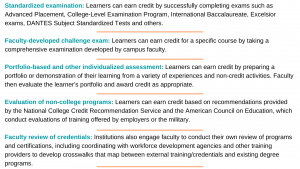Advance CTE’s “Research Round-Up” blog series features summaries of relevant research reports and studies to elevate evidence-based Career Technical Educational (CTE) policies and practices and topics related to college and career readiness. This month’s blog highlights prior learning assessment as a strategy for upskilling learners by offering college credit for previous academic and professional experiences which aligns with CTE Without Limits: A Shared Vision for the Future of Career Technical Education where each learner’s skills are counted, valued, and portable.
Prior learning assessment (PLA) is a strategy being utilized by postsecondary institutions to increase enrollment and retention of learners in their CTE programs. PLA, which is similar in design and implementation to credit for prior learning (CPL) offers benefits for both learners and institutions. These programs are effective options for adult learners that have work or academic experience but lack the credentials and the information they need to upskill to complete a degree.
Methods of PLA include:

The PLA Boost Report
The PLA Boost, released in 2020, was collaboratively produced by the Western Interstate Commission for Higher Education (WICHE) and the Council for Adult and Experiential Learning (CAEL). This study examined the use and impact of prior learning assessment (PLA) on adult outcomes using enrollment, credit-earning and degree-earning data from 72 postsecondary institutions of more than 465,000 learners of all ages, focusing in particular on more than 232,000 adult learners (defined as learners age 25 and older) from 69 of the participating institutions that were able to provide the most detailed data on PLA credit-earning.
Findings: The shared benefits of PLA to learners and institutions
When postsecondary institutions acknowledge previous education and training through PLA, it removes a barrier to returning to the classroom for adult learners by decreasing the cost of earning their degree.
Based on the report’s findings, learners can save money by taking advantage of PLA: The adult students in this sample saved an estimated average of $1,481 at two-year public institutions, $3,794 at four-year publics, $10,220 at four-year privates, and $6,090 at for-profits when considering the lower costs of PLA compared to course tuition.
In addition to saving money, PLA allows the learner to save time and reportedly, increases feelings of motivation and validation. PLA was strongly associated with higher rates of credential completion for adult learners. The 24,512 adult students who earned PLA credits had a credential completion rate of 49 percent over the seven-and-a-half-year observation period, compared to 27 percent among adult students with no PLA credits.
Adult students with PLA were more likely to persist and continue to complete their degree at their participating institution. Adult students with PLA earned an average of 17.6 more credits from institutional courses compared to adult students without PLA.
Study Limitations
The sample was overly representative of predominantly online institutions, some of the results (most notably for the sector and for race/ethnicity groups) were influenced by a handful of large institutions or by institutions where key student groups were concentrated, and there were too few students in some of the race categories (Native Hawai‘ian/Other Pacific Islander and American Indian/ Alaska Native). While this study was able to demonstrate the benefits of PLA, the sample of adult learners was relatively small. Forty percent of the participating institutions reported participation rates of under three percent of adult learners with PLA. Disaggregating this data also revealed low participation rates for female, low-income and Black adult learners compared to other subgroups. It is worth noting that, despite variation in the extent, all learner subgroups experienced credential boosts from PLA.

Recommendations and Additional Resources
Now is the time to invest in PLA. PLA offers a solution for increasing credential attainment by extending an opportunity for adult learners to upskill and/or return to complete their degrees. The data shows us that access to PLA is not equal across adult learner groups. In order to provide access for all adult learners institutions should critique their data to better identify the gaps in access and to leverage the full potential of these programs.
To learn more about strategies to increase participation in PLA and CPL, check out the Credit for Prior Learning Messaging Toolkit. This toolkit provides effective messages targeted to key audiences and strategies for dissemination to increase participation in Credit for Prior Learning among adult learners who are pursuing career pathways and CTE programs of study that lead to jobs in in-demand fields.
For state and local CTE leaders looking to increase their data literacy, Advance CTE’s Train the Trainer: Opportunity Gap Analysis Workshop focuses on the skills that leaders need to investigate outcome gaps and perform root cause analysis. These sessions will provide the necessary training and resources to support state leaders in addressing gaps in access to high-quality CTE.
Amy Hodge, Policy Associate
Tags: Adult Learners, Credit for Prior Learning, Equity, postsecondary, prior learning assessments, student outcomes

